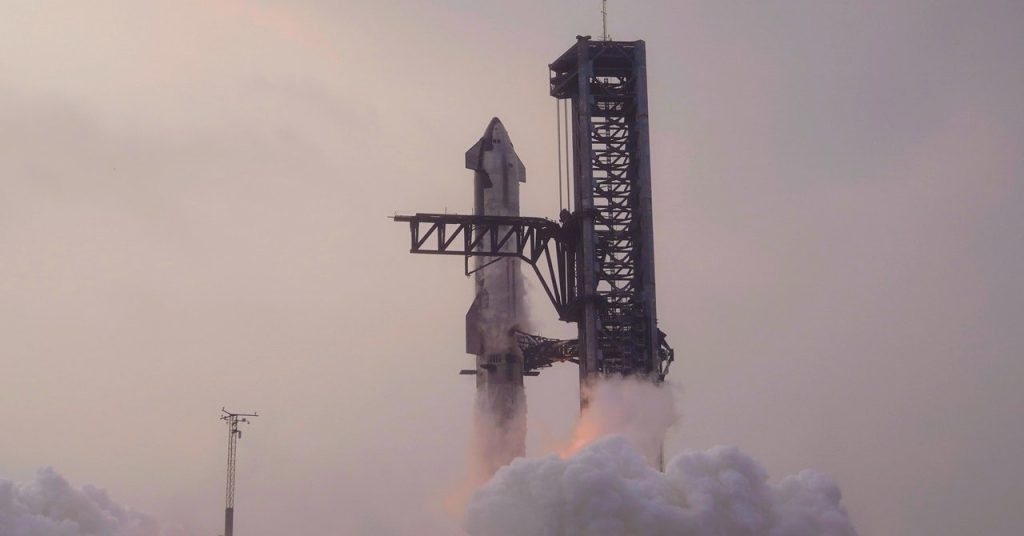SpaceX’s Starship: A Leap Towards the Moon and Mars
SpaceX has completed a largely successful fourth test of its groundbreaking Starship rocket, marking a significant milestone in the quest to return humans to the Moon and potentially land on Mars.
Launch Details
The integrated flight test 4 took off from SpaceX’s Boca Chica test site in Texas at 7:50 am Central time. The rocket, standing 233 feet (71 meters) tall, embarked on its journey with 33 engines. Despite one engine failing, the rocket’s journey to space was smooth, showcasing its design redundancy.
Starship Composition and Separation
Starship consists of two parts: the Super Heavy booster and the upper section, Starship itself. Three minutes into the flight, at an altitude of about 48 miles (78 kilometers), the two sections separated as planned. The Super Heavy booster then began its return to Earth.
Booster Landing Test
Once fully operational, the goal is for both the Super Heavy booster and Starship to land back at the launch site, caught by giant “chopsticks” on the launch tower. Today’s test aimed to have the booster descend towards the Gulf of Mexico, relight 13 of its engines, and gently splash down. This was achieved flawlessly, with the booster splashing down seven and a half minutes into the mission.
“That booster landing on the ocean was phenomenal,” says Laura Forczyk, a space consultant and founder of the George-based firm Astralytical. “That gives us confidence that SpaceX can make Starship reusable.”
Starship’s Journey and Reentry
Starship continued its journey over the Atlantic Ocean, southern Africa, and towards the Indian Ocean, reaching a peak altitude of 132 miles. It then began its reentry into Earth’s atmosphere, attempting a vertical test landing on the ocean. Traveling at 17,000 miles per hour, the vehicle faced temperatures of 2,600 degrees Fahrenheit (1,400 degrees Celsius).
Despite a smooth reentry initially, one of the two flaps used for orientation caught fire, causing significant damage. However, the vehicle survived and attempted a vertical landing at sea, impacting the ocean in an upright position.
“It got a lot further than the previous flights,” says Tripathi. “It made it all the way to the ocean. That’s a great success.”
Future Tests and Goals
There is still work to be done on Starship’s thermal protection system to ensure it can survive reentry heat. The next test flight, pending regulatory approval from the Federal Aviation Administration, could happen in a few weeks. SpaceX CEO Elon Musk mentioned that if Starship Flight 4 went smoothly, the company might attempt landing Super Heavy back on the ground rather than at sea in the next flight.
“If the landing on the ‘virtual tower’ with the booster works, we will actually try with flight five to come back and land on the tower,” Musk said. “It is in the realm of possibility.”
Long-Term Vision
Next year, SpaceX aims to prove it can transfer fuel between two Starships in space, a crucial step for lunar missions. To reach the moon, a Starship will need to refuel in space, potentially requiring more than a dozen launches. NASA’s Artemis III mission plans to use Starship to take humans to the lunar surface in September 2026.
“I do not have confidence that Artemis III will launch in September 2026, for multiple reasons, not just Starship,” says Forczyk. But today’s test shows that Starship is at least heading in the right direction, and perhaps one day, might become the giant, rapidly reusable rocket that Musk envisions can make humans a multiplanetary species.
“From the beginning of the program we’ve designed Starship to land on Mars,” said Jessica Anderson, manufacturing engineering manager at SpaceX, in the livestream of the fourth test, “something we know will take launching millions of pounds of cargo and equipment into space spread across thousands of launches.”
Starship Flight 4 is another step in that direction.

4 Comments
Absolutely groundbreaking, but how long until we actually get there?
SpaceX is really pushing the boundaries; think we’ll see boots on Mars in our lifetime?
Finally, some real progress in the space raceSPACER!
Nova: Yet another step in Elon Musk’s grand vision for humanity!